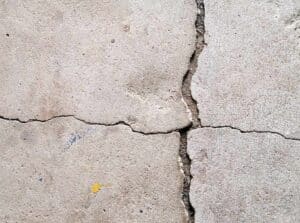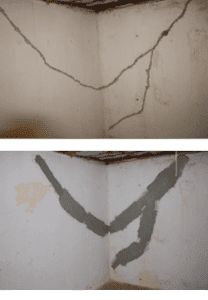When it comes to the structural integrity of your home, the foundation plays a pivotal role. Over time, various factors can lead to cracks in structural foundation crack a structural home’s foundation. Understanding the types of cracks and their significance is crucial for homeowners. In this article, we’ll delve into the different types of cracks that can appear in a home’s foundation and their implications.
Common Types of Cracks in a Home’s Foundation
1. Vertical Cracks
Vertical cracks are among the most common types of cracks that homeowners encounter in their foundation walls. These cracks typically run straight up and down diagonal foundation cracks, following the natural direction of gravity. While vertical cracks can be a cause for concern, they are not always indicative of severe structural issues.
Causes of Vertical Cracks:
Settlement: One of the primary reasons for vertical cracks is settlement. Over time, the soil beneath your home can compact, causing the foundation to settle. This settling can create stress on the concrete or masonry materials, resulting in vertical cracks.
Shrinkage: During the curing process, concrete can shrink, leading to the development of small vertical cracks. These are often referred to as “hairline cracks” and are typically not a significant concern. However, they should be monitored for any signs of widening.
Natural Aging: As homes age, minor cracks may appear due to the normal wear and tear of the materials. These may not pose an immediate threat but should be inspected periodically.
Significance and Monitoring:
Vertical cracks are not always
Width: If a vertical crack is narrow, typically less than 1/8 inch, it is often considered a cosmetic issue. However, if the crack widens over time, it may indicate ongoing settlement or other structural concerns.
Vertical Movement: Pay attention to whether the crack extends vertically or appears to move. Significant vertical movement may suggest an ongoing issue that requires professional evaluation.
Addressing Vertical Cracks:
Sealing: If the vertical crack is narrow and does not show signs of significant movement, it can be sealed using an appropriate concrete crack sealer. This can help prevent moisture intrusion and further widening.
Professional Inspection: For wider or concerning vertical cracks, it’s advisable to consult a foundation specialist. They can assess the underlying cause, determine whether it’s an isolated issue or part of a larger structural problem, and recommend appropriate repairs.
Foundation Repair: Depending on the expert’s assessment, repairs may involve solutions such as epoxy injection, carbon fiber reinforcement, or even underpinning to address settlement issues.
2. Horizontal Cracks
Horizontal cracks are one of the more concerning types of cracks that can appear non structural or in a home’s foundation. Unlike vertical cracks that run up and down, horizontal cracks typically traverse the foundation wall in a sideways direction. These cracks can indicate serious structural issues and should be addressed promptly.
Causes of Horizontal Cracks:
Horizontal cracks are often associated with more severe problems compared to vertical cracks. Some of the common causes of vertical foundation cracks include:
Excessive Lateral Pressure: Horizontal cracks can result from external forces exerting pressure on the foundation walls. This pressure can come from saturated soil, frost heaving, or expansive clay soils pushing against the foundation.
Foundation Heaving: In regions with freeze-thaw cycles, the soil around the foundation can expand and contract, causing the foundation to heave and create horizontal cracks.
Water Pressure: Hydrostatic pressure, which is the pressure exerted by water in the soil surrounding the foundation, can lead to horizontal cracks. This is particularly common in areas with poor drainage.
Significance and Warning Signs:
Horizontal cracks are significant and should not be ignored due to their potential impact on the structural integrity of the home. Warning signs associated with horizontal cracks include:
Widening: Horizontal cracks that widen over time are a strong indicator of ongoing structural issues.
Bulging or Bowing: In addition to cracks, horizontal movement can cause the foundation wall to bulge or bow outward. This is a serious sign of structural stress.
Water Intrusion: Horizontal cracks often allow water to penetrate into the basement or crawl space, leading to moisture problems, mold growth, and damage to belongings.
Addressing Horizontal Cracks:
Dealing with horizontal cracks in basement walls is a complex task that typically requires professional intervention. Here are the steps involved in addressing horizontal cracks:
Consult a Specialist: If you suspect horizontal cracks in your foundation, it’s crucial to consult with a qualified foundation specialist or structural engineer. They will conduct a thorough inspection to determine the extent of the damage and the underlying causes.
Reinforcement: Depending on the severity of the issue, solutions may involve reinforcing the foundation wall using methods such as carbon fiber strips, steel braces, or wall anchors. These methods can help stabilize the wall and prevent further movement.
Waterproofing: Addressing the issue of water intrusion is essential. Waterproofing measures, including exterior drainage systems and sealants, may be required to prevent further damage.
Foundation Replacement: In extreme cases where the foundation is severely compromised, a complete foundation replacement may be necessary to ensure the structural integrity of the home.
3. Diagonal Cracks
Diagonal cracks are another type of concrete foundation wall crack that can cause concern for homeowners. Unlike vertical or horizontal cracks that follow straight lines, diagonal cracks typically form at an angle, often appearing at a 45-degree angle to the foundation wall. These cracks can be indicative of more complex structural issues and should be examined by a professional.
Causes of Diagonal Cracks:
Diagonal cracks are often associated with a combination of factors, making their diagnosis and repair more intricate. Common causes of diagonal cracks include:
Differential Settlement: Diagonal cracks can occur when one part of the foundation settles or shifts differently than another. This can happen due to variations in soil compaction or load-bearing capacity.
Lateral Pressure: Similar to horizontal cracks, diagonal cracks can result from lateral pressure exerted on the foundation walls by soil or water.
Structural Weakness: In some cases, the design or construction of the foundation may lead to stress points that manifest as diagonal cracks over time.
Significance and Identification:
Understanding the significance of diagonal cracks is essential for homeowners. Here’s how to identify their importance:
Multiple Angles: Diagonal cracks often appear in multiple directions and may intersect. These complex patterns can be a sign of underlying structural issues.
Width and Length: Assess the width and length of diagonal cracks. If they are wide or continue to elongate, this may indicate an active problem requiring immediate attention.
Associated Symptoms: Pay attention to any other symptoms like doors or windows sticking, uneven floors, or drywall cracks. These issues may suggest that the diagonal cracks are affecting the overall structural integrity of the home.
Addressing Diagonal Cracks:
Dealing with diagonal cracks typically requires professional expertise due to their complex nature. Here are the steps involved in addressing diagonal cracks:
Professional Inspection: Contact a foundation specialist or structural engineer to conduct a thorough inspection of the cracks and the overall foundation. They will identify the root causes and assess the extent of the damage.
Foundation Repair Solutions: Depending on the diagnosis, the repair solutions may involve underpinning, wall reinforcement, or stabilization techniques. Carbon fiber reinforcement, wall anchors, or helical piers are common methods used to address diagonal cracks.
Water Management: Like other types of foundation cracks, addressing water intrusion is crucial. Ensure that drainage systems are properly installed and functioning to prevent further damage.
Monitoring: After repairs, it’s essential to monitor the foundation for any signs of further movement or cracking. Regular inspections can catch potential issues early.
4. Stair-Step Cracks
Stair-step cracks are a distinctive type of foundation crack that resemble the steps of a staircase, with each “step” representing a separate foundation crack repair part. These cracks are commonly found in brick or block foundations and may be indicative of various issues related to the foundation’s materials or construction.
Causes of Stair-Step Cracks:
Stair-step cracks can have several causes, often related to the materials used and the construction methods employed. Some common causes include:
Differential Settlement: Just like with diagonal cracks, stair-step cracks can occur due to differential settlement, where one part of the foundation settles or shifts more than another. This can result from variations in soil composition or load-bearing capacity.
Mortar Joint Failure: In brick or block foundations, the mortar joints between the individual bricks or blocks can deteriorate over time. When these joints weaken or fail, it can lead to the formation of stair-step cracks.
Thermal Expansion and Contraction: Fluctuations in temperature can cause the materials in the foundation to expand and contract. Over time, this repetitive movement can result in the development of cracks, including stair-step patterns.
Significance and Identification:
Understanding the significance of stair-step cracks is crucial for homeowners. Here’s how to identify their importance:
Pattern and Location: Stair-step cracks typically form in a zigzag pattern along the mortar joints of the foundation wall. Their location can help differentiate them from other types of cracks.
Mortar Condition: Examine the condition of the mortar joints. If the mortar is crumbling or deteriorating, it’s a sign that the cracks may be related to mortar joint failure.
Crack Width: Assess the width of the cracks. While narrow cracks may not be an immediate concern, widening cracks may indicate ongoing issues.
Additional Symptoms: Keep an eye out for other signs of foundation problems, such as uneven floors, sticking doors or windows, or moisture intrusion.
Addressing Stair-Step Cracks:
Dealing with stair-step cracks involves addressing the underlying causes of horizontal crack and restoring the structural integrity of the foundation. Here are the steps involved in addressing these cracks:
Professional Evaluation: Contact a foundation specialist or structural engineer to inspect the cracks and determine the root causes. This assessment will guide the repair process.
Mortar Joint Repair: If the cracks are primarily due to mortar joint failure, the solution may involve repointing or re-tucking the mortar joints to restore their strength and integrity.
Structural Stabilization: If the cracks are associated with more significant structural issues, solutions such as wall anchors, carbon fiber reinforcement, or underpinning may be recommended to stabilize the foundation.
Waterproofing: As with other types of foundation cracks, addressing water intrusion is essential. Ensure proper drainage systems and waterproofing measures to prevent further damage.
Regular Maintenance: After repairs, implement a routine maintenance plan to monitor the foundation’s condition and address any new cracks or issues promptly.
5. Cracks at the Corners
Cracks at the corners of a foundation are cracks that specifically appear at the junctions of the structural foundation where two walls meet, often forming a “V” shape or extending diagonally across the corner. These cracks can be indicative of various issues related to the foundation’s construction, design, or structural forces.
Causes of Cracks at the Corners:
Several factors can lead to the development of cracks at the corners of a foundation. Some common causes structural foundation cracks include:
Settlement and Shifting: Differential settlement, where one part of the foundation settles or shifts differently than another, can cause cracks to form at the corners. This can result from variations in soil compaction or load-bearing capacity.
Design and Construction: In some cases, the design and construction of the foundation may create stress points at the corners, making them susceptible to cracking over time.
Soil Conditions: Expansive soils, which expand and contract significantly with changes in moisture content, can exert pressure on the foundation and contribute to corner cracks.
Significance and Identification:
Understanding the significance of small cracks at the corners is essential for homeowners. Here’s how to identify their importance:
Location: These cracks typically occur at specific locations where two foundation walls intersect. Their position can help differentiate them from other types of cracks.
Pattern: The cracks may form a “V” shape, extend diagonally, or appear as vertical or horizontal lines. The pattern can provide clues about their origin and cause.
Crack Width: Assess the width of the cracks. Wider cracks may indicate more significant structural issues.
Corner Condition: Examine the condition of the corner itself. Any visible displacement or separation between walls can suggest that the corner crack is associated with structural movement.
Additional Symptoms: Be vigilant for other signs of foundation problems, such as doors or windows sticking, uneven floors, or moisture intrusion.
Addressing Cracks at the Corners:
Dealing with cracks at the corners involves identifying the root causes of structural cracks and implementing appropriate repairs to ensure the stability of the foundation. Here are the steps involved in addressing these cracks:
Professional Assessment: Contact
a foundation specialist or structural engineer to inspect the cracks and evaluate the foundation’s condition. Their expertise will help determine the underlying causes and the best course of action.
Reinforcement and Stabilization: Depending on the assessment, repairs may involve reinforcing the corners through methods such as carbon fiber straps, wall anchors, or underpinning. These measures can help stabilize the foundation and prevent further movement.
Waterproofing: Address any water intrusion issues associated with the cracks by implementing proper drainage systems and waterproofing measures.
Regular Monitoring: After repairs, establish a routine maintenance plan to monitor the foundation’s condition and promptly address any new cracks or issues.
In conclusion, understanding the different types of cracks in a home’s foundation and their significance is crucial for maintaining the structural integrity of your home. Regular inspections and timely repairs can help ensure that the foundation settlement of your home remains safe and stable for years to come.
Contact the Professionals at Seal-Tite Basement Waterproofing Today! 540-992-1144

Seal-tite Basement Waterproofing Co. is a full service basement environment contractor. We carry an A+ Better Business Bureau rating. We repaired over 40,000 homes and structures in Virginia, West Virginia, Tennessee, and North Carolina. We are fully insured and licensed. We have worked in all types of locations, including residential and commercial locations, government agencies, colleges, hospitals, churches, and condo associations.
Seal-tite® offers a lifetime transferable warranty. We carry a Class A Contractor’s License and we are fully insured. Our satisfied customers range from government agencies to businesses, hospitals, colleges, churches, and thousands of homeowners. Your home is probably the single largest investment you will make in your lifetime. Don’t wait, call Seal-tite® to help make your home dry, safe and livable.
 a foundation specialist or structural engineer to inspect the cracks and evaluate the foundation’s condition. Their expertise will help determine the underlying causes and the best course of action.
a foundation specialist or structural engineer to inspect the cracks and evaluate the foundation’s condition. Their expertise will help determine the underlying causes and the best course of action. Call or email for a free estimate. For immediate help call
Call or email for a free estimate. For immediate help call  Start with trust. We’re BBB A+ Rated The Top Satisfaction Rate Awarded.
Start with trust. We’re BBB A+ Rated The Top Satisfaction Rate Awarded.